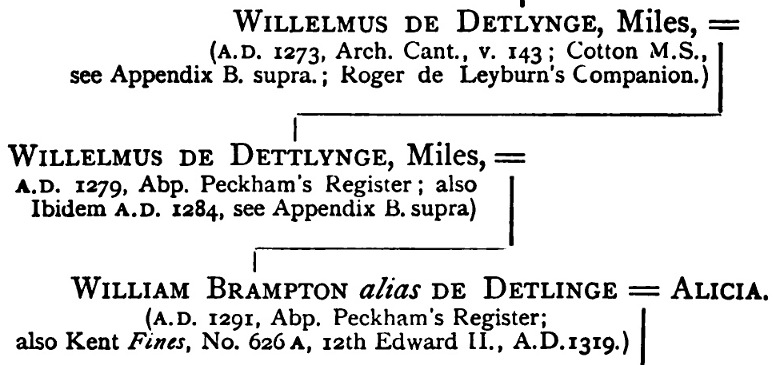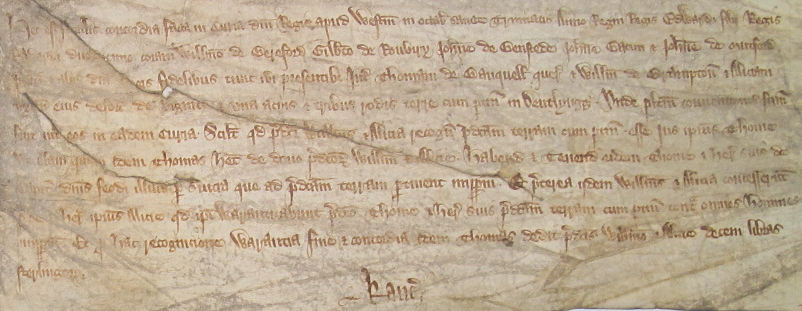- map
- how you can help
- FAQ's
- contact
- copyright
-
ahnentafel and citation # display:| |

| Snapshot: | knight in 13th- and 14th-century Kent, England |
| Parents: | Sir 4203240William Detling His mother's identity is unknown. |
| Born: | by 1304 location unknown |
| Died: | after 1334/5, and maybe by 1346 location unknown |
| Buried: | unknown |
Below is an excerpt from the pedigree that appears in: I. Cave-Browne, Detling in Days Gone By, or The History of the Parish (Maidstone and London, 1880), page 63. I believe that this portion of Cave-Browne's pedigree is ultimately correct, but that he misinterpreted one of the records cited. First I will explain Cave-Browne's error, and then I will explain why I still believe the pedigree to be correct. English translation: "The 4th day before the Kalends of May. In court at Otford, William of Dettlinge made homage and fidelity to the Lord for half a knight's fee; which land Sir William of Detling his father once held." The phrase pater ejus aliquando tenuit ("his father once held") insinuates that his father (i.e., 4203240William—if Cave-Browne's pedigree is accurate) was probably dead by 1291. However, Cave-Browne seems to have been unaware of (and doesn't mention in his book) records that prove that a certain Sir William de Detling was murdered in Detling in 1304. Who could this William (the murder victim) have been? It almost certainly wasn't the youngest To reiterate: The man who paid homage in 1291 was actually 4203240William, not

Who is

iiij
A 1319 fine shows that

Despite the apparent legal setback,
| Other records refer to "William de Detling," but because |
1: Charles Trice Martin, ed., Registrum Epistolarum Fratris Johannis Peckham, Archiepiscopi Cantuariensis, Volume III (London, 1885), page 998. As you can see, the record is dated "4 kal. Maii," i.e. four days prior to the Kalends of May 1290 using the ancient Roman calendar method. This corresponds to 28 April 1290/1. A more thorough transcription comes from: I. Cave-Browne, Detling in Days Gone By, or The History of the Parish (Maidstone and London, 1880), page 62. It reads, "iiij
2: Caroline Burt, Edward I and the Governance of England, 1272–1307 (2013), pages 217-220. Burt cites several different court records pertaining to the murder and subsequent trials; you can read the relevant excerpt and citations for yourself.
3: James Greenstreet, "Kent Fines, 10-15 Edward II," Archaeologia Cantiana Volume XIV (1882), page 259, entry 626A.
4: James Greenstreet, "Assessments in Kent for the Aid to Knight the Black Prince, Anno 20 Edward III," Archaeologia Cantiana, Volume X (1876), page 151. As you can see, Greenstreet transcribes de Johanne de Detlynge et Thoma de Bukwelle pro dimidio feodo quod Willelmus de Detlynge tenuit in Detlynge de Archiepiscopo, which might translate as "from John Detlynge and Thomas de Buckwell for half the fee which William of Detlynge held in Detlinge of the archbishop."
5: UK National Archives CP 40/717 (Court of Common Pleas / Plea Rolls / Chief Justice's roll, 18 Hen VI, Easter term), on an apparently unnumbered page pertaining to a lawsuit involving William Sonde et al. vs. John Ruton et al. I obtained an image of this record from: Anglo-American Legal Tradition, O'Quinn Law Library, University of Houston; <http://aalt.law.uh.edu/AALT1/H6/CP40no717/bCP40no717dorses/IMG_1261.htm>, accessed 29 March 2022. You can see AALT's index entry for this record at <http://aalt.law.uh.edu/Indices/CP40Indices/CP40no717/CP40no717Pl.htm> by searching "1262." As you can see, the original record is in Latin, so refer to the abstract in: George Wrottesley, Pedigrees from the Plea Rolls: Collected from the Pleadings in the Various Courts of Law, A.D. 1200 to 1500, from the Original Rolls in the Public Record Office, page 371.
6: Reverend L. B. Larking, "On the Heart-Shrine in Leybourne Church," Archaeologia Cantiana, Volume V (1863), page 143. Larking references a somewhat obscure, anonymous, but contemporaneous manuscript whose origin he further describes on page 166.
7: I obtained an image of this record from: Anglo-American Legal Tradition, O'Quinn Law Library, University of Houston; <http://aalt.law.uh.edu/AALT7/CP25(1)/CP25_1_101_97-112/IMG_0264.htm>, accessed 16 April 2022.
8: I. Cave-Browne, Detling in Days Gone By, or The History of the Parish (Maidstone and London, 1880), page 63. Cave-Browne is clearly transcribing an earlier record, but I can't find the corresponding UK National Archives reference ID.
9: H. A. Hanley and C. W. Chalklin, The Kent Lay Subsidy Roll of 1334/5 page 117.